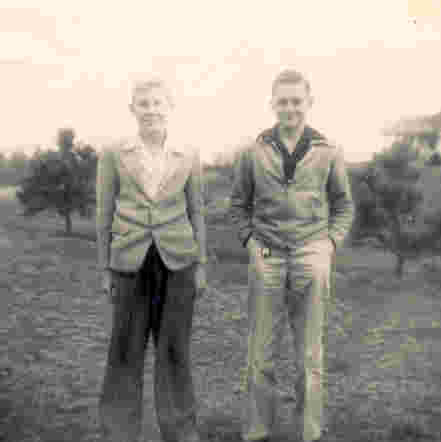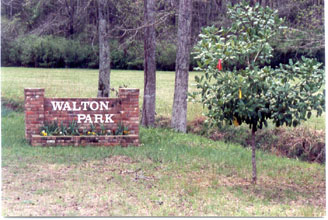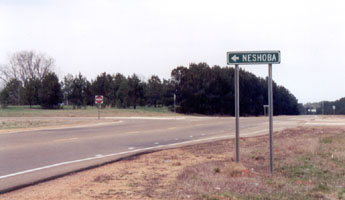|
The History of Neshoba
Church and Community
 Written 1977 by
the late Miss Thelma McBeath (Thelma credited
"Neshoba" by Willie Joe Houston, and the Neshoba Church Minutes
1877-1977) Written 1977 by
the late Miss Thelma McBeath (Thelma credited
"Neshoba" by Willie Joe Houston, and the Neshoba Church Minutes
1877-1977)
(Pictured right is the old Neshoba Post Office.
Postmistresses during this writer's childhood and adolescence were Ethie
Crenshaw McNair & Claudine Howle.)
We have never been able to learn just who were the first white
settlers in what is now the Neshoba community, but certain it is that by the
early 1850's there were more Choctaw Indians than white people in this immediate
community. Among some of those Indians were Sam, Amy, and Wilkerson
Tonubby. They still lived mostly by hunting and fishing. Also, a
hundred years ago we find such familiar names as Walton, Crenshaw, Heflin,
Herrington, Gully, and Rhodes as families living within a radius of 3 or 4 miles
of this community. It is probable that one Wiley Heflin lived where Mrs.
Delia Johnson (the Susie Bassett house) now lives, and that Hamp Herrington
lived at the J. P. Harrison place with no other house this side of Santiago and
not more than five or six this side of Dixon.
 There were no large land or slave owners but rather small
independent farmers moving here from Georgia, Tennessee, or the Carolinas.
The land was covered with timber which had to be cut, piled and burned before it
could be put into cultivation. Each family had to be pretty self
sufficient, for there were no churches, schools, mills or doctors in the
community. The old A & V Railroad was completed from Meridian to
Vicksburg and the farmers began hauling their produce to such markets as Newton,
Hickory, or Meridian. These trips were made twice a year by wagon over
terrible roads. There was no closer store, school, church or post office
than Union. This community was called Waltonville. There were no large land or slave owners but rather small
independent farmers moving here from Georgia, Tennessee, or the Carolinas.
The land was covered with timber which had to be cut, piled and burned before it
could be put into cultivation. Each family had to be pretty self
sufficient, for there were no churches, schools, mills or doctors in the
community. The old A & V Railroad was completed from Meridian to
Vicksburg and the farmers began hauling their produce to such markets as Newton,
Hickory, or Meridian. These trips were made twice a year by wagon over
terrible roads. There was no closer store, school, church or post office
than Union. This community was called Waltonville.
At the outbreak of the war between the states, practically every
household sent one or two sons or the husband to fight.... Those who
returned, came back to terrible poverty and distress, and had to start life over
again in 1865.
About the beginning of the Civil War, Wiley Heflin gave two
acres of land for a cemetery, with the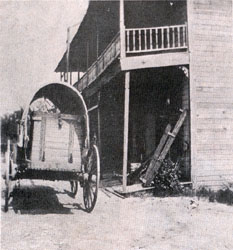 stipulation that his grave was to be as
near the center of the plot as possible. His daughter, Dollie Heflin, was
the first person to be buried in what is now Neshoba Cemetery; she died
during the Civil War. stipulation that his grave was to be as
near the center of the plot as possible. His daughter, Dollie Heflin, was
the first person to be buried in what is now Neshoba Cemetery; she died
during the Civil War.
(Pictured Right: Lewis Store circa early 1900's)
In 1870, a little subscription, or pay school was organized in a
one room log house not far from where Thomas Lamar Howle's pond is now
located. By 1877, a larger building was constructed of logs on the present
site of the Old Neshoba School grounds. This was known as Crenshaw
school. It was in this same building that the first Baptist church was
organized by twenty-eight people, one hundred years ago....
The first post office established in the community was in the
early 1890's, and was known as Centralis. This post office was in the
store of John Harrison on what is now the Jessie Pilgrim's place, and mail was delivered
three times a week by horseback until the first R.F.D. was established from
Union in 1903.
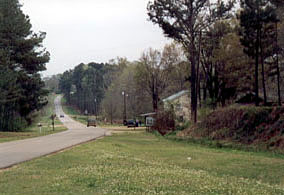 (Pictured
left and throughout the remainder of the article is the Neshoba of April 2002.) (Pictured
left and throughout the remainder of the article is the Neshoba of April 2002.)
By July 1905, steel was laid through what is now Neshoba, for
the first railroad in the county. This work was being done during the
annual 4th of July picnic so some of the people took the first train ride of
their lives; this trip was about a half mile on a work train. Just
before the building of the railroad, Charlie Herrington built a little store on
the Mid Fulton place. A little later the Crenshaw and McCraw stores were
built.
In 1905 the Post Office Department established a post office and
gave it the name of Neshoba, with D. P. Jackson as the first postmaster.
Mr. Jackson served only a few months and was succeeded by Bartha Gross. Others
who served as postmasters were Mrs. Harrison, Mrs. Neva Vance, Miss Nettie
Ingram, Mr. Jack Ingram, Mrs. Ethie McNair, and Mrs. Claudine Howle.
(Discontinued in 1976)
In 1907 a depot was built just north of where the stores were,
at that time, with Mr.. Keeton as the first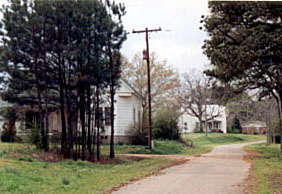 depot agent. Some others were
Carl Crews, Hugh McKinney, Mr. Windham, and Mr. George Andrews. This
agency was discontinued about 1933. Just after the completion of the
depot, a bank and three brick stores were built just west of it. These
stores were occupied by McGraw and Son, Viverett and Vance, and W. W.
McBeath. Other stores on that same side were O.D. Crenshaw, J. D. Petty
and Van Grafton. There was a drug store and doctor's office owned by Dr.
Crosby, in addition to the prior mentioned stores. On the south side of
the street was a wagon and buggy store, also a large two-story building and
department store owned by J. T. Lewis. East of the Lewis store was an
up-to-date hardware store owned by J. W. Burroughs, while directly across the
street from the McCraw store was another two-story sheet metal building
operated as a machine shop by George and Irvin Smith. depot agent. Some others were
Carl Crews, Hugh McKinney, Mr. Windham, and Mr. George Andrews. This
agency was discontinued about 1933. Just after the completion of the
depot, a bank and three brick stores were built just west of it. These
stores were occupied by McGraw and Son, Viverett and Vance, and W. W.
McBeath. Other stores on that same side were O.D. Crenshaw, J. D. Petty
and Van Grafton. There was a drug store and doctor's office owned by Dr.
Crosby, in addition to the prior mentioned stores. On the south side of
the street was a wagon and buggy store, also a large two-story building and
department store owned by J. T. Lewis. East of the Lewis store was an
up-to-date hardware store owned by J. W. Burroughs, while directly across the
street from the McCraw store was another two-story sheet metal building
operated as a machine shop by George and Irvin Smith.
In addition, Mr. Mack Howington had built a two story frame
building to be used as a hotel on a lot just north of where Mrs. Abb Mott's
house now stands. A big sawmill and dry kiln had been built just east of
the railroad, and was operated by H. O. Cooper until 1914. Mr.. J. J.
Herrington owned a prosperous sawmill and gin business until about 1919.
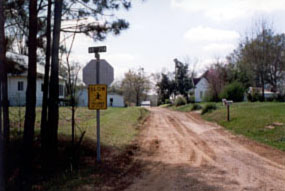 At one time Neshoba had two Physicians, Dr. T. O. Crosby and Dr.
I. E. Jarvis. For a while Dr. Jess Johnson and Mr. Hugh McDonald had
dental offices here. The first cashier of the bank, R. W. Patrick, was
followed by Leon Lewis, who served as a cashier and manager until the bank went
out of business in the fall of 1917. At one time Neshoba had two Physicians, Dr. T. O. Crosby and Dr.
I. E. Jarvis. For a while Dr. Jess Johnson and Mr. Hugh McDonald had
dental offices here. The first cashier of the bank, R. W. Patrick, was
followed by Leon Lewis, who served as a cashier and manager until the bank went
out of business in the fall of 1917.
In the fall of 1906, the school was moved to a new two-story
building about where the church now stands. Services were held in the
school until the new church was completed in 1907. In August 1950 the
church decided to buy the Jimmy Smith house for $1,200. It was to be
remodeled and used as the first pastor's home....
Neshoba Church and community furnished it's full share of young
men who gave their lives fighting for this country. In World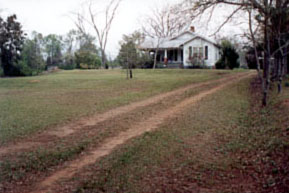 War I there
was Glover Pilgrim and Bobby Houston. In World War II, Walter (Mutt) Rhodes
and Lionel Brown did not return. War I there
was Glover Pilgrim and Bobby Houston. In World War II, Walter (Mutt) Rhodes
and Lionel Brown did not return.
From this community many have gone on to be successful business
men and women, attorneys, teachers, and ministers.... One unusual
distinction enjoyed perhaps by no other...community in the United States is that
three students from the same class later went to Peabody College in Nashville,
Tenn. and in succession each became president of the student body of that
institution. Those young men were Thomas Walton, Cecil Walton, and Berlin
Vance.
Thelma McBeath died May 8, 2003 and is buried in Neshoba
Cemetery in the heart of the community that she loved. It is due to her
diligence in preserving articles, pictures and information regarding Neshoba's
history that this section of the Web Page is possible.
|
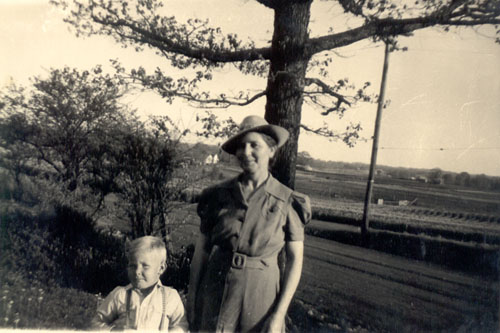
 Written 1977 by
the late Miss Thelma McBeath (Thelma credited
"Neshoba" by Willie Joe Houston, and the Neshoba Church Minutes
1877-1977)
Written 1977 by
the late Miss Thelma McBeath (Thelma credited
"Neshoba" by Willie Joe Houston, and the Neshoba Church Minutes
1877-1977) There were no large land or slave owners but rather small
independent farmers moving here from Georgia, Tennessee, or the Carolinas.
The land was covered with timber which had to be cut, piled and burned before it
could be put into cultivation. Each family had to be pretty self
sufficient, for there were no churches, schools, mills or doctors in the
community. The old A & V Railroad was completed from Meridian to
Vicksburg and the farmers began hauling their produce to such markets as Newton,
Hickory, or Meridian. These trips were made twice a year by wagon over
terrible roads. There was no closer store, school, church or post office
than Union. This community was called Waltonville.
There were no large land or slave owners but rather small
independent farmers moving here from Georgia, Tennessee, or the Carolinas.
The land was covered with timber which had to be cut, piled and burned before it
could be put into cultivation. Each family had to be pretty self
sufficient, for there were no churches, schools, mills or doctors in the
community. The old A & V Railroad was completed from Meridian to
Vicksburg and the farmers began hauling their produce to such markets as Newton,
Hickory, or Meridian. These trips were made twice a year by wagon over
terrible roads. There was no closer store, school, church or post office
than Union. This community was called Waltonville. stipulation that his grave was to be as
near the center of the plot as possible. His daughter, Dollie Heflin, was
the first person to be buried in what is now Neshoba Cemetery; she died
during the Civil War.
stipulation that his grave was to be as
near the center of the plot as possible. His daughter, Dollie Heflin, was
the first person to be buried in what is now Neshoba Cemetery; she died
during the Civil War. (Pictured
left and throughout the remainder of the article is the Neshoba of April 2002.)
(Pictured
left and throughout the remainder of the article is the Neshoba of April 2002.) depot agent. Some others were
Carl Crews, Hugh McKinney, Mr. Windham, and Mr. George Andrews. This
agency was discontinued about 1933. Just after the completion of the
depot, a bank and three brick stores were built just west of it. These
stores were occupied by McGraw and Son, Viverett and Vance, and W. W.
McBeath. Other stores on that same side were O.D. Crenshaw, J. D. Petty
and Van Grafton. There was a drug store and doctor's office owned by Dr.
Crosby, in addition to the prior mentioned stores. On the south side of
the street was a wagon and buggy store, also a large two-story building and
department store owned by J. T. Lewis. East of the Lewis store was an
up-to-date hardware store owned by J. W. Burroughs, while directly across the
street from the McCraw store was another two-story sheet metal building
operated as a machine shop by George and Irvin Smith.
depot agent. Some others were
Carl Crews, Hugh McKinney, Mr. Windham, and Mr. George Andrews. This
agency was discontinued about 1933. Just after the completion of the
depot, a bank and three brick stores were built just west of it. These
stores were occupied by McGraw and Son, Viverett and Vance, and W. W.
McBeath. Other stores on that same side were O.D. Crenshaw, J. D. Petty
and Van Grafton. There was a drug store and doctor's office owned by Dr.
Crosby, in addition to the prior mentioned stores. On the south side of
the street was a wagon and buggy store, also a large two-story building and
department store owned by J. T. Lewis. East of the Lewis store was an
up-to-date hardware store owned by J. W. Burroughs, while directly across the
street from the McCraw store was another two-story sheet metal building
operated as a machine shop by George and Irvin Smith. At one time Neshoba had two Physicians, Dr. T. O. Crosby and Dr.
I. E. Jarvis. For a while Dr. Jess Johnson and Mr. Hugh McDonald had
dental offices here. The first cashier of the bank, R. W. Patrick, was
followed by Leon Lewis, who served as a cashier and manager until the bank went
out of business in the fall of 1917.
At one time Neshoba had two Physicians, Dr. T. O. Crosby and Dr.
I. E. Jarvis. For a while Dr. Jess Johnson and Mr. Hugh McDonald had
dental offices here. The first cashier of the bank, R. W. Patrick, was
followed by Leon Lewis, who served as a cashier and manager until the bank went
out of business in the fall of 1917. War I there
was Glover Pilgrim and Bobby Houston. In World War II, Walter (Mutt) Rhodes
and Lionel Brown did not return.
War I there
was Glover Pilgrim and Bobby Houston. In World War II, Walter (Mutt) Rhodes
and Lionel Brown did not return.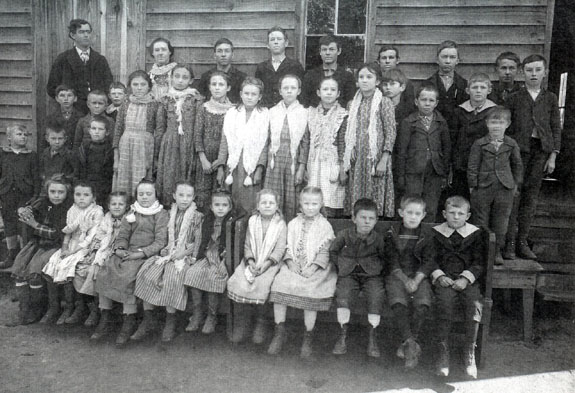
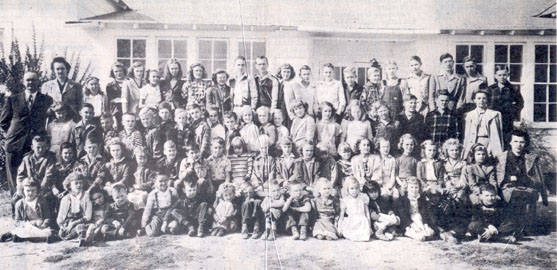

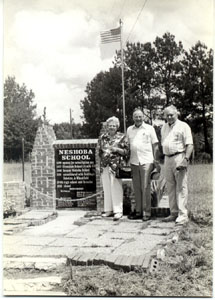
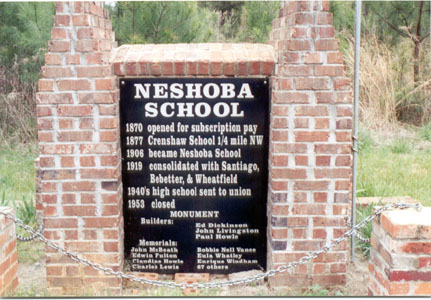
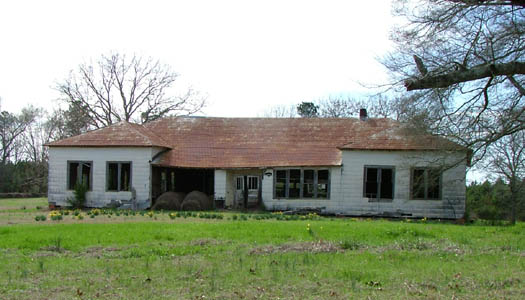

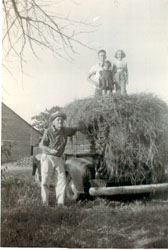
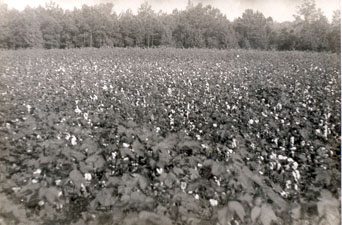 Don't ever put your cotton in someone else's
sack. This is one of the most important lessons you can learn early in
life. When time came to pick cotton, the fields were populated with
pickers who packed their sacks with cotton. When a sack was full, it was
weighed by Granddaddy, and logged in a book for eventual payment to the
picker. Of course when Lynn & I expressed our desire to pick,
Granddaddy made us tiny child sized cotton sacks with straps over the shoulder,
just like the big guys. We were elated! But the Mississippi heat
soon turned cotton picking into a boring job for a child. We lost interest
fast. From time to time though, we would return to the field and pick a
handful of bolls, usually dropping them into Harold Mott's (pictured atop the
hay truck above) cotton sack.
That is, until Granddaddy explained to us that when we put our cotton into
Harold's sack, Harold got paid and we didn't. Lessons in life are learned
early in the cotton field.
Don't ever put your cotton in someone else's
sack. This is one of the most important lessons you can learn early in
life. When time came to pick cotton, the fields were populated with
pickers who packed their sacks with cotton. When a sack was full, it was
weighed by Granddaddy, and logged in a book for eventual payment to the
picker. Of course when Lynn & I expressed our desire to pick,
Granddaddy made us tiny child sized cotton sacks with straps over the shoulder,
just like the big guys. We were elated! But the Mississippi heat
soon turned cotton picking into a boring job for a child. We lost interest
fast. From time to time though, we would return to the field and pick a
handful of bolls, usually dropping them into Harold Mott's (pictured atop the
hay truck above) cotton sack.
That is, until Granddaddy explained to us that when we put our cotton into
Harold's sack, Harold got paid and we didn't. Lessons in life are learned
early in the cotton field.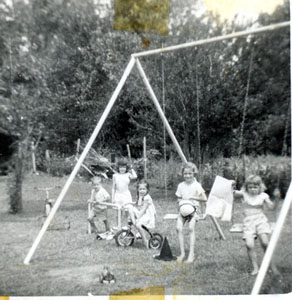 One's
own backyard held a treasure of adventures to be enjoyed with friends.
There was a swing, see-saw, bikes, wagons, a sand-box, and scores of fruit trees
bearing cyclical delights. (Pictured 1957 left to right: Lamar
Howle, Marsha Howle, Lynn Mills, Carol Mills, Gayle Howle). Red clay
banks along the road provided wonders of entertainment. You could build
tiny villages, scale their heights, start dirt wars, or just rest under the
shade of a sheltering tree. In the woods were plenty of areas perfect for
building fortresses. The creek was cool and clear and featured sand bars,
adding to our wading pleasure. Before the old school closed in 1953,
recess down the road sounded like a glorious affair. One quickly learned
that if you succumbed to the lure and traveled down the road to visit with the
recessing older kids, you got into a great deal of trouble when your
Mother discovered the adventure.
One's
own backyard held a treasure of adventures to be enjoyed with friends.
There was a swing, see-saw, bikes, wagons, a sand-box, and scores of fruit trees
bearing cyclical delights. (Pictured 1957 left to right: Lamar
Howle, Marsha Howle, Lynn Mills, Carol Mills, Gayle Howle). Red clay
banks along the road provided wonders of entertainment. You could build
tiny villages, scale their heights, start dirt wars, or just rest under the
shade of a sheltering tree. In the woods were plenty of areas perfect for
building fortresses. The creek was cool and clear and featured sand bars,
adding to our wading pleasure. Before the old school closed in 1953,
recess down the road sounded like a glorious affair. One quickly learned
that if you succumbed to the lure and traveled down the road to visit with the
recessing older kids, you got into a great deal of trouble when your
Mother discovered the adventure.